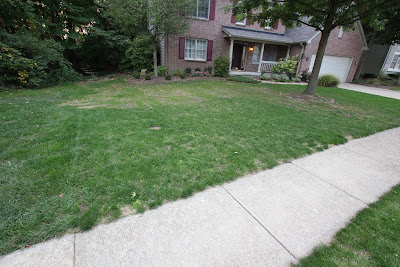Today marks seven weeks after germination, which means it's time to fertilize according to the Purdue guide I've been
following. Since we are forecast to get rain tonight and/or tomorrow, I decided to get it done today. I applied 5 lbs of 32-0-4 Scott's fertilizer (5.7% slow release Nitrogen, which I think is a good amount for this time of year since there isn't much growing time left) over the 1600 sq. ft. of the front yard using my little broadcast spreader which resulted in roughly 1 lb Nitrogen per 1000 sq ft. I didn't apply any to the backyard - I never know what to do back there...
As
promised, here are some photos of the front and backyard taken yesterday.
The front yard is looking decent. There are some streaks of thin to no grass due to uneven seeding, but overall I think it'll turn out ok eventually... I hope...
Unfortunately, there isn't much to see in the backyard. Supina bluegrass grows extremely slowly and didn't appear to germinate very well. The few patches of grass that there are look pretty nice, but overall I think it was a flop. I don't know what I'm going to do...
I think I'm about ready for winter...






























